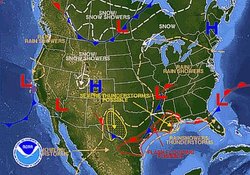Synoptic weather (Weather & Climate)
Contents
Synoptic weather
Introduction Forecast map. (Source: NOAA (Synoptic weather) )
We all have come to depend upon reliable standardized reports of current weather conditions that have become available from various media through the science of meteorology. Radio, television, newspapers, the Internet all provide a continuous stream of information on weather—whether it be local, national, regional or global. All of this information arises from forecasts derived from synoptic weather measurements, or synoptic meteorology. These measurements arguably are the most highly developed activities in the range of environmental monitoring techniques.
Synoptic meteorology
Synoptic means "view together" or "view at a common point". Synoptic meteorology is primarily concerned with large-scale weather systems, such as extratropical cyclones and their associated fronts but not as large as the global scale in the previous section. In this section, we will acquaint you with the structure and behavior these smaller scale features.
The forecast weather map (right) is an example of the use of synoptic meterology. Since local time varies around the world, meteorologists around the world need a common point in time if their observations are to have any meaning to their neighbors.
The accepted common point in time is called the Universal Time Coordinate (UTC) also referred to as Zulu time (Z). You will notice all weather maps, radar, and satellite images all have their time expressed in UTC. Doing so allows the many different elements that create our weather (e.g. the high and low pressure systems, fronts, and precipitation areas) can be viewed together at the same instant.
What is the "Z" time where you live?
With synoptic meterology useful in observing weather patterns the most visible patterns we can see are via clouds (Clouds). We begin by looking clouds and how they form.
Further Reading
In November 2008, the National Academies released Observing Weather and Climate from the Ground Up: A Nationwide Network of Networks. The report notes that, "[d]etailed weather observations on local and regional levels are essential to a range of needs from forecasting tornadoes to making decisions that affect energy security, public health and safety, transportation, agriculture and all of our economic interests. As technological capabilities have become increasingly affordable, businesses, state and local governments, and individual weather enthusiasts have set up observing systems throughout the United States. However, because there is no national network tying many of these systems together, data collection methods are inconsistent and public accessibility is limited."
Reference
- National Weather Service— Synoptic Meteorology.
